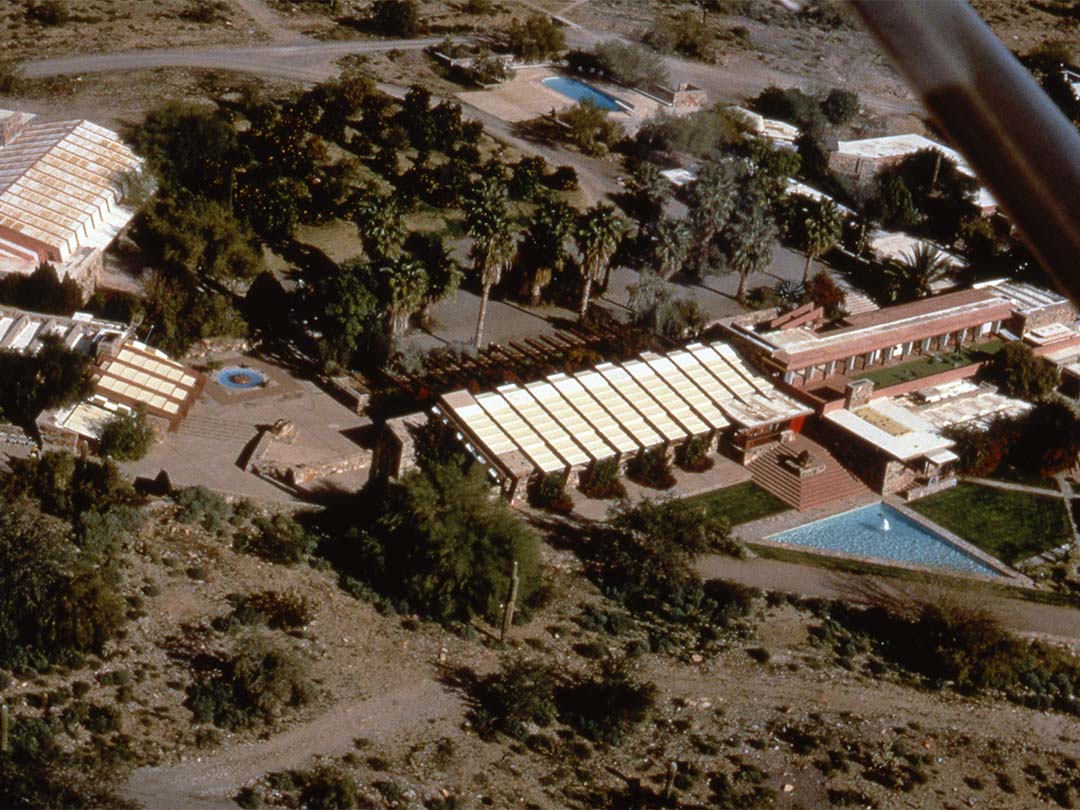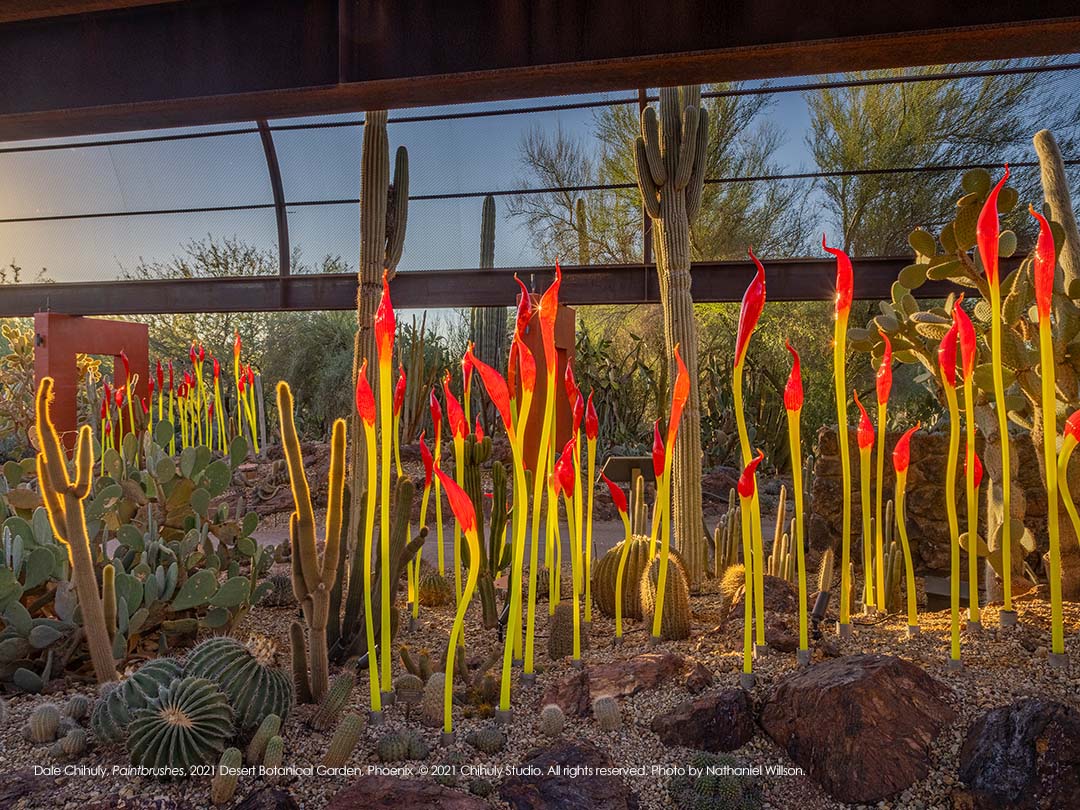Nature has always been a great inspiration to many artists and leaders. A canvas painting. Architecture. Garden landscapes. Photography. Even exhibitions.
Through all these forms, nature finds a way to complement the work of the artist. In the Valley, look no further than to Chihuly in the Desert, an exhibition co-presented by Desert Botanical Garden and Frank Lloyd Wright’s Taliesin West, on view now through June 19.
For the first time in the Phoenix area, guests will experience nature, architecture and art collide in this blockbuster exhibition. Throughout the spring, visitors will see firsthand a rich conversation between artists and nature. At each site, visitors will learn how nature inspired each artist. The cactus and wildflowers that start blooming will emphasize that connection even more and leave guests astonished.
Before your visit to Chihuly in the Desert, learn how Garden founder Gertrude Webster, Frank Lloyd Wright and Dale Chihuly were influenced by nature.
Desert Botanical Garden
Before the Garden first opened to the public in 1939, a group of local residents, including Webster, came together with a sole purpose to save and care for desert plants by creating a botanical garden. To this day, conservation is at the forefront of the Garden’s work and mission.
Webster arrived to Phoenix as a winter resident in 1928 from Vermont, building an adobe mansion on 11 acres on the south slope of Camelback Mountain. After returning from a trip to Switzerland in the early 1930s with rare cactus, she sought advice on how to raise them from the Arizona Cactus and Native Flora Society, the local group that founded the Garden. She quickly cultivated an interested in cactus and became a member.
In 1936, Webster was nominated as president of the group. Soon after, Webster rallied community support to create a botanical garden in Phoenix.
Webster was an integral supporter and voice in creating the Garden. Today, the Garden continues to honor Webster’s mission to save and care for desert plants of the world through research, education and exhibition.
As guests step into the Garden, they will witness this decades-long work of preserving cactus and desert plants through the beauty of landscape and design.
When they first walk into the Garden, they’ll see Chihuly’s “Fiori Boat” surrounded by pink Parry’s penstemon, fishhook barrel cactus topped with its yellow fruits and a beautiful Papago butte from a distance. From the start of the experience, guests will be left awestruck.

Taliesin West
At Taliesin West, visitors will learn and see how Wright was inspired by the desert landscape.
Wright was a native of Wisconsin’s green, rolling hills, so the Sonoran Desert was exotic and exciting to him when he first arrived to Arizona in the 1920s, said Niki Stewart, Vice President and Chief Learning and Engagement Officer for The Frank Lloyd Wright Foundation.
The famed architect took into consideration the natural world and vistas when he designed his winter home. This principle is known as organic architecture.
“One of the key tenets of organic architecture is consideration of the site,” Stewart said. “He believed that buildings should be intrinsically linked to the site they are built upon, taking the natural elements into account. Every part of the design is made for that site specifically – the placement of the structures, the materials and colors used, and the way spaces connect with the natural world are all carefully created to fit in that space.”
Visitors will notice this design at every corner at Taliesin West. Cactus and yucca inspired Wright to design angles and shadow shapes in the buildings itself. Even the pointed shapes of the mountains inspired the angular shapes of the rooflines.
“And, the rich colors of the desert and sky inspired the palette of colors we see at Taliesin West, even today,” she said.
In the background of Chihuly’s “Marine Blue and Citron Tower” at Taliesin West lies a citrus grove that has been at the property since before 1959. The trees give Chihuly’s artwork depth and vibrancy. If guests look at certain angles within the site, it encapsulates the magic pairing of Wright and Chihuly’s work.
The citrus grove was planted after Wright’s death, to his original specifications — and has been cared for and maintained in that layout ever since, said Fred Prozzillo, Vice President of Preservation.
“This addition was one of three major changes Wright made to Taliesin West the year before his death. The other two were the layout of the garden squares (adjacent to the grove), and the re-routing of the approach to the site, bringing guests up the divided entry drive we use today,” he said. “There’s a grid layout to the grove and the garden squares that can be easily seen in aerial photography – and, nowadays, using online maps.”

Dale Chihuly
Chihuly doesn’t shy away from stating that his masterpieces draw inspiration from the natural world. After all, nature is one of Chihuly’s biggest inspirations when creating these large-scale glass installations. “A lot of my work looks like if you ran across it in the wild, you wouldn’t know if it was manmade or made by nature,” he said.
Visitors will see that in all 18 installations and a curated indoor gallery of Chihuly in the Desert. Each artwork is filled with vibrant colors, whimsical shapes and captivating textures.
Part of that inspiration came from his mom’s interest in flowers and gardening. Chihuly’s mom was an avid gardener who dedicated the majority of their backyard in Tacoma to a very big garden.
“We had 90 rhododendrons and about the same amount of azaleas. So, I know that flowers have had a big influence on me,” he said.
His mother’s flowers also led him to experiment with many colors in his work. He brings that inspiration to the Sonoran Desert at the Garden and Taliesin West. During spring, visitors will have the opportunity to experience all these worlds collide and connect.
Cactus flowers start basking in the sunny weather. Wright’s architectural design flourishes where nature and glass meet. And Chihuly’s artwork will leave you mesmerized.
Chihuly in the Desert is on display through June 19 at the Garden and Taliesin West.
Purchase your tickets here


